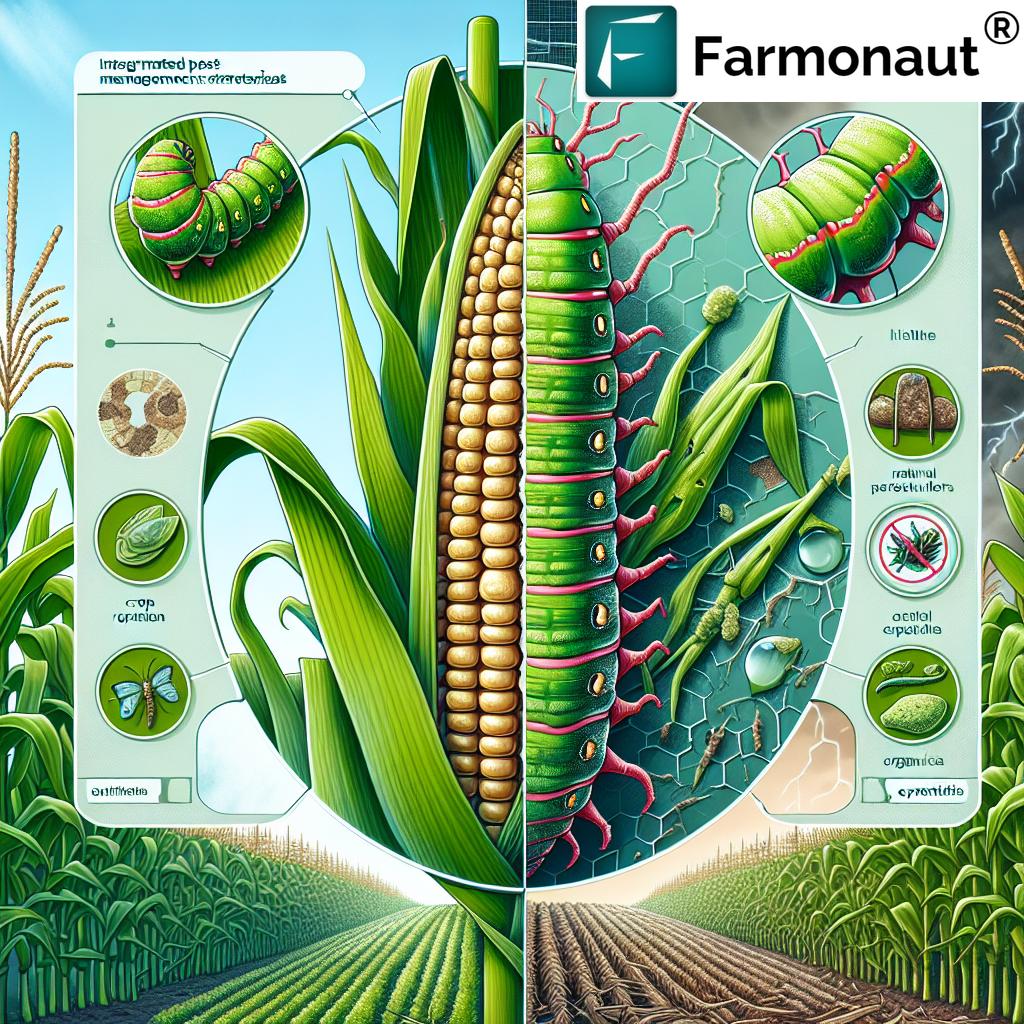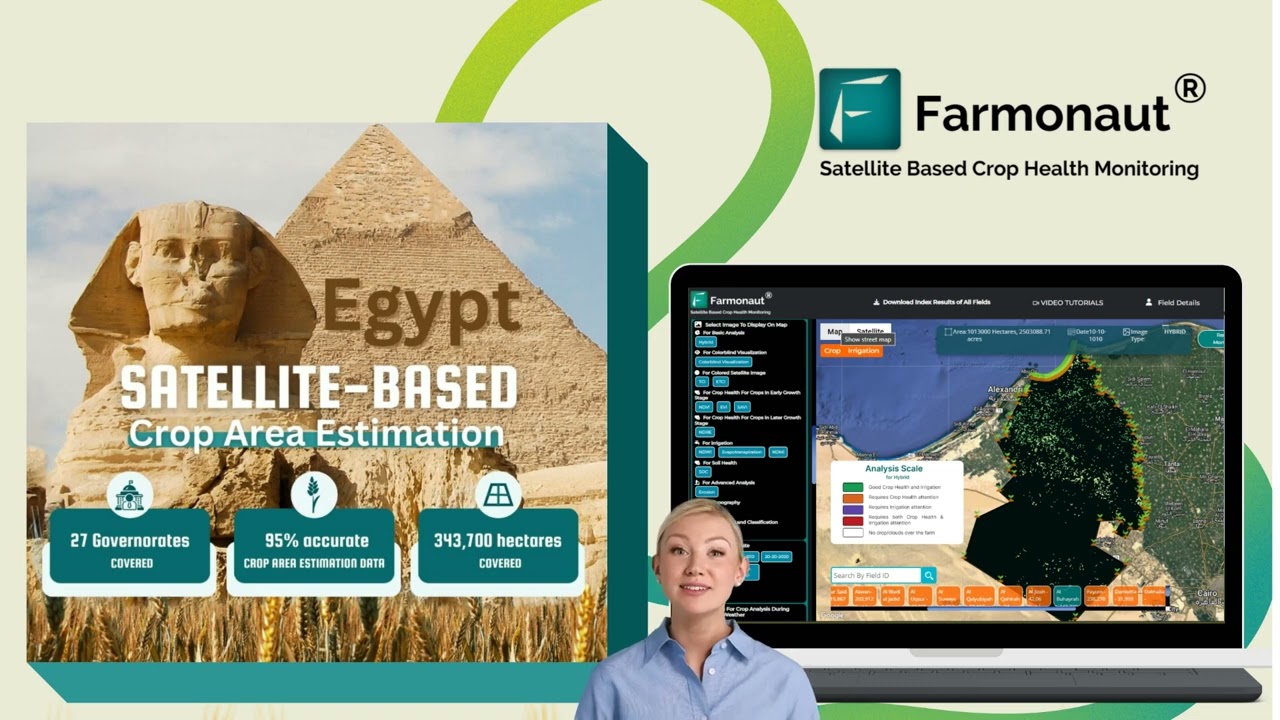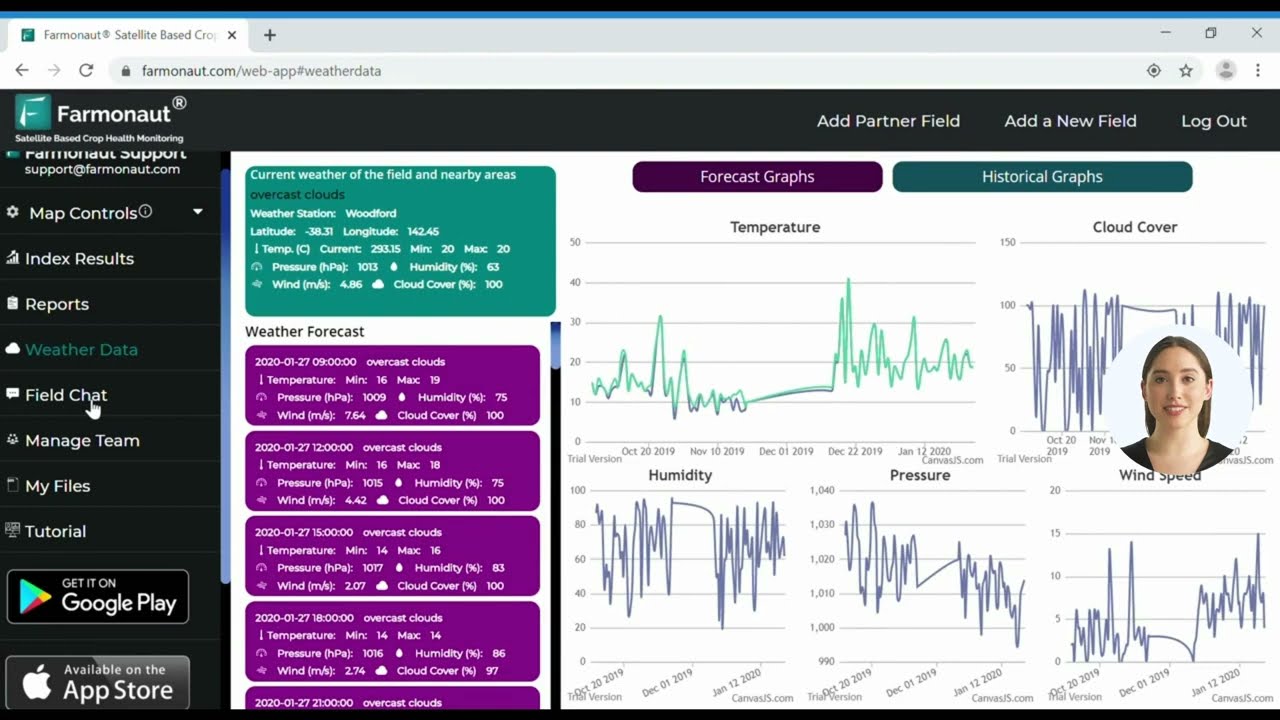Mastering Fall Armyworm Control: Integrated Pest Management Strategies for Sustainable Crop Protection
“Fall armyworm can damage up to 80% of maize crops if left unchecked, affecting millions of farmers worldwide.”
Welcome to our comprehensive guide on mastering fall armyworm control through integrated pest management strategies. As agricultural experts, we understand the devastating impact this invasive pest can have on crops, particularly maize, rice, and cotton. In this article, we’ll explore effective fall armyworm control techniques, sustainable pest control methods, and the importance of early pest detection in agriculture.
At Farmonaut, we’re committed to providing farmers with cutting-edge solutions for crop monitoring and management. Our satellite-based technology offers real-time insights into crop health, helping you stay ahead of pest infestations and optimize your yield. Before we dive into the specifics of fall armyworm management, let’s take a moment to understand why this pest is such a significant threat to agriculture worldwide.

Understanding the Fall Armyworm: A Formidable Agricultural Threat
The fall armyworm, scientifically known as Spodoptera frugiperda, is a notorious pest that has been causing significant damage to crops across the globe. This voracious insect is particularly problematic due to its rapid reproduction rate and ability to feed on a wide range of host plants. Let’s delve into the key aspects of this pest to better understand how to combat it effectively.
The Life Cycle of Fall Armyworm
Understanding the fall armyworm life cycle is crucial for implementing timely and effective control measures. The life cycle of this pest consists of four main stages:
- Egg Stage: Female moths lay clusters of 100-200 eggs on the underside of leaves. These eggs hatch within 2-3 days.
- Larval Stage: This is the most destructive phase, lasting about 14-21 days. The caterpillars go through six instars, growing rapidly and causing significant damage to crops.
- Pupal Stage: The mature larvae burrow into the soil to pupate. This stage lasts about 7-10 days.
- Adult Stage: The adult moths emerge from the soil and begin the cycle anew, with females capable of laying up to 1,000 eggs in their lifetime.
The rapid progression through these stages makes early detection and intervention crucial for effective control.
Host Range and Crop Preference
Fall armyworm is a polyphagous pest, meaning it can feed on various plant species. However, it shows a strong preference for graminaceous crops. The primary hosts include:
- Maize (corn)
- Rice
- Sorghum
- Sugarcane
Additionally, it can infest other crops such as:
- Cotton
- Peanuts
- Soy
- Alfalfa
This wide host range makes fall armyworm a particularly challenging pest to manage, as it can easily move between different crops in an area.
The Economic Impact of Fall Armyworm Infestations
The fall armyworm’s voracious appetite and rapid reproduction rate can lead to devastating economic losses for farmers. In severe cases, crop losses can reach up to 100%, particularly in maize fields. The economic impact extends beyond direct crop damage, affecting:
- Food security in affected regions
- Increased production costs due to pest control measures
- Reduced export potential for infested crops
- Disruption of local and national economies reliant on agriculture
Given these significant impacts, implementing effective fall armyworm control strategies is not just beneficial—it’s essential for sustainable agriculture and food security.
Integrated Pest Management: A Holistic Approach to Fall Armyworm Control
Integrated pest management for crops (IPM) is a comprehensive approach that combines various control methods to manage pest populations effectively while minimizing environmental impact. When it comes to fall armyworm control, IPM strategies are particularly effective. Let’s explore the key components of an IPM program for fall armyworm:
1. Monitoring and Early Detection
Early pest detection in agriculture is crucial for effective control. Regular field scouting and monitoring are essential to identify fall armyworm infestations in their early stages. Here are some key monitoring techniques:
- Visual Inspection: Regularly inspect crops for signs of damage, egg masses, or larvae.
- Pheromone Traps: Use traps to monitor adult moth populations and predict potential outbreaks.
- Satellite-Based Monitoring: Utilize advanced technologies like Farmonaut’s satellite imagery to detect changes in crop health that may indicate pest presence.
By implementing these monitoring techniques, farmers can detect fall armyworm infestations early and take prompt action to prevent widespread damage.
2. Cultural Control Practices
Cultural control practices are preventive measures that make the crop environment less favorable for pest development. Some effective cultural control methods for fall armyworm include:
- Crop Rotation: Implement crop rotation techniques to disrupt the pest’s life cycle and reduce overwintering populations.
- Planting Dates: Adjust planting dates to avoid peak fall armyworm activity periods.
- Field Sanitation: Remove crop residues and weeds that can serve as alternate hosts for the pest.
- Intercropping: Plant companion crops that may repel or confuse fall armyworm moths.
These practices not only help in managing fall armyworm but also contribute to overall soil health and biodiversity in the agricultural ecosystem.
3. Biological Control
Biological control involves using natural enemies of the fall armyworm to keep its population in check. This method is an essential component of sustainable pest control methods. Some effective biological control agents include:
- Parasitoid Wasps: Species like Trichogramma and Telenomus remus that parasitize fall armyworm eggs.
- Predatory Insects: Ladybugs, lacewings, and predatory bugs that feed on fall armyworm eggs and larvae.
- Entomopathogenic Fungi: Fungi like Beauveria bassiana and Metarhizium anisopliae that infect and kill fall armyworm larvae.
- Bacillus thuringiensis (Bt): A naturally occurring soil bacterium that produces proteins toxic to fall armyworm larvae.
Encouraging and conserving these beneficial organisms can significantly reduce the need for chemical interventions.

4. Chemical Control: A Last Resort
While chemical control should be considered a last resort in an IPM program, it may be necessary in cases of severe infestations. When using insecticides for fall armyworm control, consider the following:
- Selective Insecticides: Choose products that target fall armyworm while minimizing harm to beneficial insects.
- Timing of Applications: Apply insecticides when larvae are young and most vulnerable.
- Rotation of Active Ingredients: Rotate between different classes of insecticides to prevent the development of resistance.
- Precision Application: Use targeted application methods to reduce overall pesticide use and environmental impact.
It’s crucial to follow all safety guidelines and local regulations when applying chemical controls. At Farmonaut, we provide real-time crop health data that can help you make informed decisions about when and where to apply treatments, maximizing efficacy while minimizing unnecessary chemical use.
“Integrated Pest Management can reduce pesticide use by 50% while maintaining effective fall armyworm control in agricultural fields.”
Organic Alternatives for Fall Armyworm Control
For farmers looking to implement organic insecticide alternatives, there are several effective options available. These methods align with sustainable farming practices and can be integrated into a comprehensive IPM strategy:
- Neem Oil: Extracted from the neem tree, this natural insecticide disrupts the feeding and growth of fall armyworm larvae.
- Pyrethrin: Derived from chrysanthemum flowers, pyrethrin is effective against a wide range of insects, including fall armyworm.
- Spinosad: A naturally occurring soil bacterium that is toxic to fall armyworm but has low toxicity to beneficial insects and mammals.
- Diatomaceous Earth: This fine powder made from fossilized algae can deter fall armyworm larvae when applied to plant surfaces.
These organic alternatives can be particularly effective when used in combination with other IPM strategies, such as cultural and biological control methods.
Implementing Effective Fall Armyworm Treatment Options
When it comes to implementing fall armyworm treatment options, timing and precision are crucial. Here are some key considerations for effective treatment:
1. Targeting Vulnerable Life Stages
Focus control efforts on the most vulnerable larval stages of the fall armyworm. Early instar larvae are more susceptible to both biological and chemical controls. Monitor fields closely to identify the presence of young larvae and time interventions accordingly.
2. Precision Application Techniques
Utilize precision agriculture technologies to improve the efficacy of control measures. Farmonaut’s satellite-based crop monitoring system can help identify areas of infestation, allowing for targeted treatment applications. This approach not only improves control but also reduces unnecessary pesticide use.
3. Integrated Approach
Combine multiple control methods for maximum effectiveness. For example, use pheromone traps to monitor adult moth populations, implement cultural practices to reduce favorable conditions for the pest, and apply biological or chemical controls as needed based on infestation levels.
4. Regular Evaluation and Adaptation
Continuously assess the effectiveness of your control strategies and be prepared to adapt your approach as needed. Factors such as changing weather patterns, pest resistance, and crop growth stages may necessitate adjustments to your management plan.
By implementing these strategies and leveraging advanced technologies like those offered by Farmonaut, farmers can significantly improve their fall armyworm control efforts and protect their crops more effectively.
The Role of Technology in Fall Armyworm Management
Advancements in agricultural technology are playing an increasingly important role in pest management, including the control of fall armyworm. Here’s how technology is revolutionizing our approach to pest control:
1. Satellite-Based Crop Monitoring
Farmonaut’s satellite-based crop monitoring system offers a powerful tool for early pest detection and management. By analyzing multispectral imagery, we can detect changes in crop health that may indicate pest infestations before they become visible to the naked eye. This early warning system allows farmers to take proactive measures to control fall armyworm populations before they cause significant damage.
Learn more about our satellite-based crop monitoring solution:
2. AI-Powered Pest Identification
Artificial intelligence and machine learning algorithms are being developed to accurately identify fall armyworm and assess infestation levels based on images of crop damage. These tools can help farmers quickly diagnose pest problems and make informed decisions about control measures.
3. Precision Application Systems
GPS-guided sprayers and drones equipped with precision application technology allow for targeted pesticide application. This reduces overall chemical use while maximizing the effectiveness of treatments against fall armyworm.
4. Mobile Apps for Real-Time Information
Mobile applications provide farmers with instant access to pest management information, weather forecasts, and treatment recommendations. Farmonaut’s mobile app offers these features and more, empowering farmers to make data-driven decisions in the field.
Download our mobile apps for on-the-go crop monitoring:
By leveraging these technological advancements, farmers can significantly improve their ability to detect, monitor, and control fall armyworm infestations, leading to more sustainable and effective pest management practices.
Preventing Insecticide Resistance in Fall Armyworm Populations
Insecticide resistance management is a critical aspect of long-term fall armyworm control. As this pest has shown a remarkable ability to develop resistance to various chemical controls, implementing strategies to prevent or delay resistance is essential. Here are key approaches to managing insecticide resistance:
1. Rotation of Active Ingredients
Regularly rotate between different classes of insecticides with different modes of action. This practice helps prevent the selection pressure that leads to resistance development. Develop a rotation plan that includes at least three different insecticide classes over a growing season.
2. Integrated Pest Management (IPM)
Implement a comprehensive IPM program that reduces reliance on chemical controls. By incorporating cultural, biological, and mechanical control methods, you can minimize the selection pressure for resistance while effectively managing fall armyworm populations.
3. Proper Application Techniques
Ensure that insecticides are applied at the correct rate, timing, and coverage. Improper application can lead to sublethal exposure, which accelerates the development of resistance. Use calibrated equipment and follow manufacturer recommendations for optimal efficacy.
4. Monitoring and Surveillance
Regularly monitor fall armyworm populations for signs of resistance development. Conduct susceptibility tests to detect any shifts in pest response to insecticides. Early detection of resistance allows for timely adjustments to management strategies.
5. Preservation of Refuge Areas
When using genetically modified crops (e.g., Bt maize), maintain non-Bt refuge areas as recommended. These refuges help preserve susceptible individuals in the pest population, slowing the development of resistance to Bt toxins.
6. Collaboration and Information Sharing
Participate in regional resistance management programs and share information about pest control practices and resistance issues with neighboring farmers and agricultural experts. Collective action is crucial for effective resistance management on a broader scale.
By implementing these strategies, farmers can significantly reduce the risk of insecticide resistance development in fall armyworm populations, ensuring the long-term effectiveness of chemical control options when they are needed.
Fall Armyworm Control Strategies Comparison
| Control Strategy | Effectiveness (1-5) | Cost (1-5) | Environmental Impact (1-5) | Implementation Difficulty (1-5) |
|---|---|---|---|---|
| Cultural Practices | 3 | 1 | 5 | 2 |
| Biological Control | 4 | 3 | 5 | 3 |
| Chemical Control | 5 | 4 | 2 | 2 |
| Organic Alternatives | 3 | 3 | 4 | 3 |
| Integrated Pest Management | 5 | 3 | 4 | 4 |
Note: Ratings are on a scale of 1-5, where 5 is the highest (most effective, most expensive, most environmentally friendly, or most difficult to implement).
The Future of Fall Armyworm Control: Emerging Technologies and Approaches
As we look to the future of fall armyworm management, several promising technologies and approaches are on the horizon. These innovations have the potential to revolutionize pest control strategies and improve crop protection:
1. Gene Editing and RNA Interference (RNAi)
Researchers are exploring the use of gene editing techniques like CRISPR and RNAi to develop fall armyworm-resistant crop varieties or to create species-specific pest control methods. These approaches could provide highly targeted control with minimal environmental impact.
2. Advanced Pheromone Technologies
Next-generation pheromone traps and lures are being developed to improve monitoring and mating disruption techniques. These tools could enhance early detection capabilities and provide more effective, non-toxic control options.
3. Predictive Modeling and Big Data Analytics
By combining historical pest data, weather patterns, and crop information, advanced predictive models can forecast fall armyworm outbreaks with greater accuracy. This allows for proactive management strategies and more efficient resource allocation.
4. Drone and Robotic Technologies
Unmanned aerial vehicles (UAVs) and ground-based robots equipped with high-resolution cameras and sensors can provide detailed, real-time crop health information. These technologies enable precise pest monitoring and targeted treatment applications.
5. Novel Biological Control Agents
Ongoing research is identifying new natural enemies and developing improved formulations of existing biological control agents. These advancements could lead to more effective and sustainable fall armyworm management options.
At Farmonaut, we’re committed to staying at the forefront of these technological advancements. Our platform is continuously evolving to incorporate the latest innovations in agricultural technology, providing farmers with cutting-edge tools for pest management and crop optimization.
Conclusion: A Holistic Approach to Fall Armyworm Management
Mastering fall armyworm control requires a comprehensive, integrated approach that combines traditional pest management practices with cutting-edge technologies. By implementing a diverse range of strategies—from cultural and biological controls to precision agriculture techniques—farmers can effectively manage this persistent pest while minimizing environmental impact and preserving long-term crop productivity.
Key takeaways for successful fall armyworm management include:
- Early detection through regular monitoring and advanced technologies
- Implementation of integrated pest management (IPM) strategies
- Utilization of biological control agents and organic alternatives where possible
- Judicious use of chemical controls with proper resistance management
- Adoption of precision agriculture tools for targeted interventions
- Continuous learning and adaptation of management strategies
By embracing these principles and leveraging innovative solutions like those offered by Farmonaut, farmers can protect their crops from fall armyworm damage while promoting sustainable agricultural practices. Remember, effective pest management is an ongoing process that requires vigilance, adaptability, and a commitment to sustainable farming practices.
For more information on how Farmonaut’s satellite-based crop monitoring and management solutions can support your fall armyworm control efforts, visit our website or contact our team of agricultural experts.
Explore Farmonaut’s advanced agricultural solutions:
Together, we can build a more resilient and productive agricultural future, safeguarding our crops against the challenges posed by pests like the fall armyworm.
Frequently Asked Questions (FAQ)
- Q: What is the most effective method for controlling fall armyworm?
A: The most effective approach is an integrated pest management (IPM) strategy that combines cultural practices, biological control, and judicious use of chemical controls when necessary. Early detection and timely intervention are key to successful management. - Q: How can I identify fall armyworm in my crops?
A: Look for irregular holes in leaves, sawdust-like frass near leaf whorls, and characteristic markings on the caterpillars, including an inverted ‘Y’ on the head capsule. Regular field scouting is essential for early detection. - Q: Are there any natural predators of fall armyworm?
A: Yes, several natural enemies can help control fall armyworm populations, including parasitoid wasps, predatory bugs, birds, and some bat species. Encouraging these natural predators can be an effective part of a biological control strategy. - Q: How often should I monitor my fields for fall armyworm?
A: During the growing season, fields should be monitored at least weekly, with more frequent checks during peak pest activity periods or in areas known to have high fall armyworm pressure. - Q: Can crop rotation help control fall armyworm?
A: Yes, crop rotation can be an effective cultural control method. Rotating to non-host crops can disrupt the pest’s life cycle and reduce overwintering populations in the field.




















